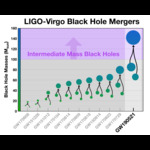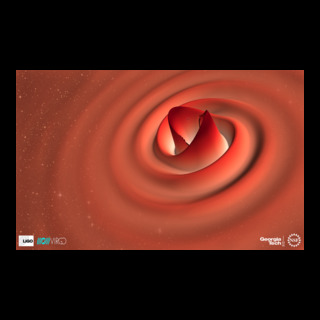Numerical simulation of a heavy black-hole merger (GW190521)
Numerical simulation of two black holes that inspiral and merge, emitting gravitational waves. The black holes have large and nearly equal masses, with one only 3% more massive than the other. The simulated gravitational wave signal is consistent with the observation made by the LIGO and Virgo gravitational wave detectors on May 21st, 2019 (GW190521).
Details on the visualization:
- The "apparent horizon" of the black holes in the simulation are shown in black. At 0:10 the simulation finds an enveloping apparent horizon that signals the two black holes have merged.
- The gravitational radiation is translated to colors around the black holes. The colors transition from blue, representing weak radiation, to red, representing strong radiation. Specifically, the coloring represents the real part of the gravitational wave strain. The strain is computed from the simulation’s extrapolated waveform, which is shown at the bottom of the screen.
- Only the mass-ratio of the two black holes is relevant for the numerical simulation, not their total mass. The large total mass inferred for the black holes that produced the GW190521 signal only affects the conversion from simulation-time to real-time that is shown at the bottom of the screen. The movie shows approximately half of the observed inspiral duration reported for the GW190521 detection.
Credit: N. Fischer, H. Pfeiffer, A. Buonanno (Max Planck Institute for Gravitational Physics), Simulating eXtreme Spacetimes (SXS) Collaboration
- Date
- September 2, 2020
- Location
- LIGO Lab
- ID
- ligo20200902v1
- Type
- Simulation
- Credit
- N. Fischer, H. Pfeiffer, A. Buonanno (Max Planck Institute for Gravitational Physics), Simulating eXtreme Spacetimes (SXS) Collaboration












